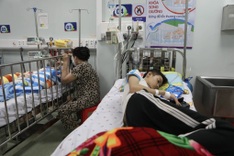Almost 100,000 people categorised as the nation’s poorest have escaped from poverty over the past year thanks to the Government’s efforts to combat poverty in the most underprivileged districts by 2020. Since its debut a year ago, the Government’s Resolution 30a on poverty reduction in 62 poorest districts has helped bring down the poverty rate from 47 per cent to 43 per cent.
Since its debut a year ago, the Government’s Resolution 30a on poverty reduction in 62 poorest districts has helped bring down the poverty rate from 47 per cent to 43 per cent.
The population of the districts was 2.4 million last year.
The figures were announced at the resolution’s one-year review meeting held in the northern province of Lao Cai under chairmanship of Deputy Prime Minister Nguyen Sinh Hung.
Deputy head of the Ministry of Labour, Invalids and Social Affairs’ Social Welfare Department Ngo Truong Thi said the outcome proved that the resolution had made steady progress.
The resolution aims to support targeted population in their production,employment and income generation via offering them forest land to grow timber trees, guiding them to restructure their farming or sending them to work overseas.
Localities have adopted combined measures to help lift the most needy ones out of poverty.
Building them new houses to replace the dilapidated ones is one of the measures introduced.
“The Government aims to get most of the poor new homes to celebrate this Tet (lunar new year) [which falls on February 14],” Thi said.
Statistics from the ministry showed that 62 districts are short of 77,000 houses in total.
With the funding from the State budget and corporations as well as soft loans, 77 per cent of the need has been met so far.
“What’s special about this programme is it follows the Prime Minister’s instruction to not allow construction tender. All the houses must be built using local labour so as to minimise the cost,” Thi said.
In Dien Bien Dong, one of four districts categorised as the nation’s poorest in the northern mountain province of Dien Bien, 1,000 new houses have been erected, according to its People’s Committee chairman Do Van Ruan.
“The same figure is expected to be completed ahead of Tet and the work will continue on 600 more houses until next April before the rainy season arrives,” Ruan said.
With VND18 million (US$1,000) funded by the State and a corporation sponsor plus VND8 million ($440) loaned with no interest by the Bank for Social Policies, Ruan said it’s possible to make a wooden 24sq.m house for each poor family.
He also said wiping out the dilapidated houses was the first priority of the district before other anti-poverty measures were taken.
“Until they find stability in solid houses, we’ll support each family with a buffalo for their farming purposes and help them restructure their cultivation of plants and trees, all are crucial to increase the community capacity,” Ruan said.
One of the solutions mapped out from the resolution’s guidelines to the targeted districts is to offer vocational training to local people and send cadres from districts to work at commune levels.
According to the ministry, some districts have prioritised allocating capital to open vocational training classes with the participation of 8,500 poor labourers who are either employed on-the-spot or sent to work abroad upon graduation.
Over VND5 billion ($277,000) has been earmarked for the task.
Thi said due to the programme’s distinct feature of being designed and implemented at the same time, there weren’t any sociological surveys on the demand for human resources in the districts.
The problem is compounded with low education levels among local residents, therefore eliminating illiteracy is also a priority.
“We also face difficulties in staff rotation, as even districts have a lack of cadres,” Thi said, adding that only 27 districts in 14 provinces have been involved in the project.
“Next year, the programme will take more heed of labour training. The General Department of Vocational Training has been assigned to construct a proper training and employment plan since man power remains a key point to the problem,” Thi said.
According to Luu Hong Son, chief of the ministry’s secretariat, under the Government’s directive, 41 State-owned economic groups, corporations or enterprises have stepped in to support the poorest districts.
They have pledged VND2.1 trillion ($116 million) worth of aid for the localities between 2009 and 2020.
Son said though most of the businesses had set up steering boards to execute the resolution 30a and designed their own plans, the support was unevenly distributed to different districts.
So far, the Viet Nam National Textile and Garment Group is the only one that has offered support in job generation by building a garment factory in Son Dong District in the northern province of Bac Giang.
The VND42 billion ($2.3 million)-factory is expected to generate 1,000 jobs – which officials hail as a sustainable approach to tackling poverty.
Ruan from Dien Bien Dong District admitted that when infrastructure was ready, it’s also necessary to encourage local people – who are mainly of ethnic minorities – to act on their own initiative instead of relying on outside funding sources.
“In the long run, we expect to eradicate social evils such as drug-use, which are the root of poverty in the region. This will require a lot of money and labour,” Ruan said.
The programme will strive to reduce the poverty rate to under 40 per cent by the end of next year.
Poverty fight starts to work
Almost 100,000 people categorised as the nation's poorest have escaped from poverty over the past year.
Source: NNN-VNS




















